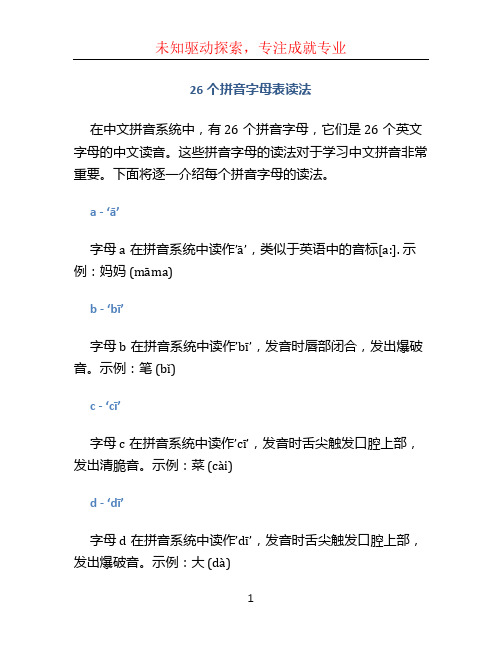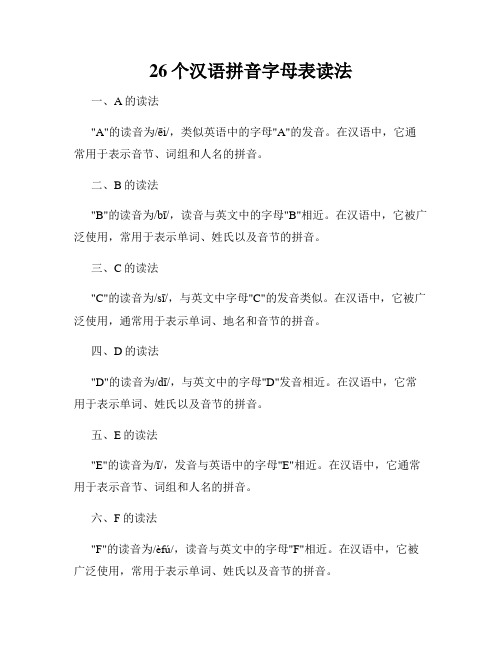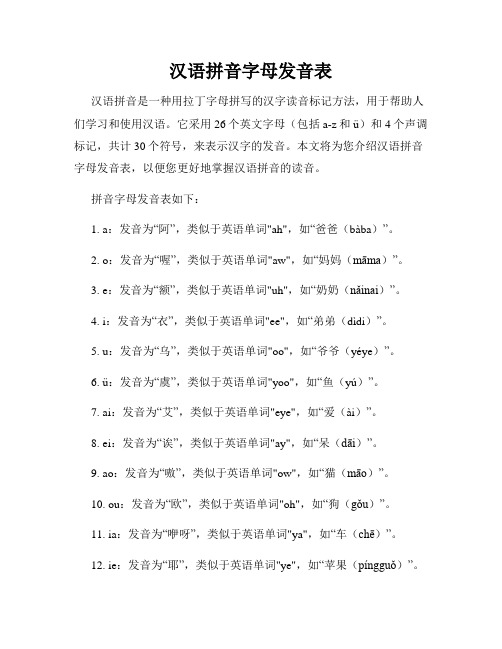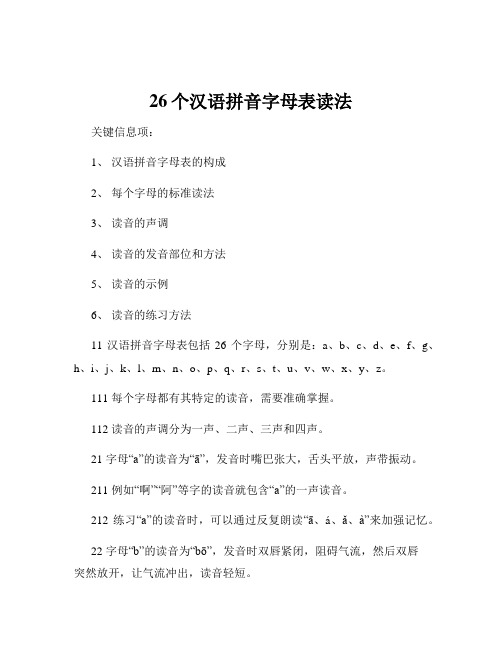自然拼音,二十六个字母的读音
26个拼音字母表读法

26个拼音字母表读法在中文拼音系统中,有26个拼音字母,它们是26个英文字母的中文读音。
这些拼音字母的读法对于学习中文拼音非常重要。
下面将逐一介绍每个拼音字母的读法。
a - ‘ā’字母a在拼音系统中读作’ā’,类似于英语中的音标[a:]. 示例:妈妈(māma)b - ‘bī’字母b在拼音系统中读作’bī’,发音时唇部闭合,发出爆破音。
示例:笔(bǐ)c - ‘cī’字母c在拼音系统中读作’cī’,发音时舌尖触发口腔上部,发出清脆音。
示例:菜 (cài)d - ‘dī’字母d在拼音系统中读作’dī’,发音时舌尖触发口腔上部,发出爆破音。
示例:大 (dà)字母e在拼音系统中读作’ē’,类似于英语中的音标[e]. 示例:鹅 (é)f - ‘fū’字母f在拼音系统中读作’fū’,发音时上齿与下唇轻触,发出爆破音。
示例:风(fēng)g - ‘gē’字母g在拼音系统中读作’gē’,发音时舌尖触发口腔后部,同时声带震动,发出清脆音。
示例:歌(gē)h - ‘hē’字母h在拼音系统中读作’hē’,发音时气流通过喉咙狭窄的通道,发出爆破音。
示例:好 (hǎo)i - ‘ī’字母i在拼音系统中读作’ī’,类似于英语中的音标[i:]. 示例:衣(yī)字母j在拼音系统中读作’jī’,发音时舌尖触发口腔上部,发出爆破音。
示例:机(jī)k - ‘kē’字母k在拼音系统中读作’kē’,发音时后部的软腭与舌尖接触,发出爆破音。
示例:可(kě)l - ‘lī’字母l在拼音系统中读作’lī’,发音时舌尖轻轻触碰上齿龈,发出脱颖而出的音。
示例:了 (le)m - ‘mí’字母m在拼音系统中读作’mí’,发音时上齿紧贴下唇,发出爆破音。
示例:妹 (mèi)n - ‘nī’字母n在拼音系统中读作’nī’,发音时舌尖触发齿龈,发出爆破音。
示例:你(nǐ)字母o在拼音系统中读作’ō’,类似于英语中的音标[o:]. 示例:哦 (ò)p - ‘pī’字母p在拼音系统中读作’pī’,发音时双唇紧闭,发出爆破音。
26个汉语拼音字母表读法

26个汉语拼音字母表读法一、A的读法"A"的读音为/ēi/,类似英语中的字母"A"的发音。
在汉语中,它通常用于表示音节、词组和人名的拼音。
二、B的读法"B"的读音为/bī/,读音与英文中的字母"B"相近。
在汉语中,它被广泛使用,常用于表示单词、姓氏以及音节的拼音。
三、C的读法"C"的读音为/sī/,与英文中字母"C"的发音类似。
在汉语中,它被广泛使用,通常用于表示单词、地名和音节的拼音。
四、D的读法"D"的读音为/dī/,与英文中的字母"D"发音相近。
在汉语中,它常用于表示单词、姓氏以及音节的拼音。
五、E的读法"E"的读音为/ī/,发音与英语中的字母"E"相近。
在汉语中,它通常用于表示音节、词组和人名的拼音。
六、F的读法"F"的读音为/èfú/,读音与英文中的字母"F"相近。
在汉语中,它被广泛使用,常用于表示单词、姓氏以及音节的拼音。
七、G的读法"G"的读音为/jī/,与英文中的字母"G"发音相近。
在汉语中,它常用于表示单词、姓氏以及音节的拼音。
八、H的读法"H"的读音为/èiči/,与英文中字母"H"的发音类似。
在汉语中,它被广泛使用,通常用于表示单词、地名和音节的拼音。
九、I的读法"I"的读音为/ài/,与英文中的字母"I"发音相近。
在汉语中,它常用于表示单词、姓氏以及音节的拼音。
十、J的读法"J"的读音为/diéi/,读音与英文中的字母"J"相近。
汉语拼音字母发音表

汉语拼音字母发音表汉语拼音是一种用拉丁字母拼写的汉字读音标记方法,用于帮助人们学习和使用汉语。
它采用26个英文字母(包括a-z和ü)和4个声调标记,共计30个符号,来表示汉字的发音。
本文将为您介绍汉语拼音字母发音表,以便您更好地掌握汉语拼音的读音。
拼音字母发音表如下:1. a:发音为“阿”,类似于英语单词"ah",如“爸爸(bàba)”。
2. o:发音为“喔”,类似于英语单词"aw",如“妈妈(māma)”。
3. e:发音为“额”,类似于英语单词"uh",如“奶奶(nǎinai)”。
4. i:发音为“衣”,类似于英语单词"ee",如“弟弟(dìdi)”。
5. u:发音为“乌”,类似于英语单词"oo",如“爷爷(yéye)”。
6. ü:发音为“虞”,类似于英语单词"yoo",如“鱼(yú)”。
7. ai:发音为“艾”,类似于英语单词"eye",如“爱(ài)”。
8. ei:发音为“诶”,类似于英语单词"ay",如“呆(dāi)”。
9. ao:发音为“嗷”,类似于英语单词"ow",如“猫(māo)”。
10. ou:发音为“欧”,类似于英语单词"oh",如“狗(gǒu)”。
11. ia:发音为“咿呀”,类似于英语单词"ya",如“车(chē)”。
12. ie:发音为“耶”,类似于英语单词"ye",如“苹果(píngguǒ)”。
13. ua:发音为“哇”,类似于英语单词"wa",如“夸(kuā)”。
14. uo:发音为“窝”,类似于英语单词"wo",如“我(wǒ)”。
26个汉语拼音字母表读法

26个汉语拼音字母表读法关键信息项:1、汉语拼音字母表的构成2、每个字母的标准读法3、读音的声调4、读音的发音部位和方法5、读音的示例6、读音的练习方法11 汉语拼音字母表包括26 个字母,分别是:a、b、c、d、e、f、g、h、i、j、k、l、m、n、o、p、q、r、s、t、u、v、w、x、y、z。
111 每个字母都有其特定的读音,需要准确掌握。
112 读音的声调分为一声、二声、三声和四声。
21 字母“a”的读音为“ā”,发音时嘴巴张大,舌头平放,声带振动。
211 例如“啊”“阿”等字的读音就包含“a”的一声读音。
212 练习“a”的读音时,可以通过反复朗读“ā、á、ǎ、à”来加强记忆。
22 字母“b”的读音为“bō”,发音时双唇紧闭,阻碍气流,然后双唇突然放开,让气流冲出,读音轻短。
221 像“爸”“波”等字就带有“b”的读音。
222 练习“b”的读音,可以尝试连读“bō、bí、bǐ、bì”。
23 字母“c”的读音为“cī”,发音时舌尖抵住上门齿背,阻碍气流,让较强的气流从缝中挤出,摩擦成音。
231 比如“刺”“此”等字包含“c”的读音。
232 练习时可重复“cī、cí、cǐ、cì”。
31 字母“d”的读音为“dē”,发音时舌尖抵住上牙床,憋住气流后突然放开,气流从口腔迸出,爆发成音。
311 常见的如“大”“的”等字有“d”的读音。
312 多念“dē、dé、dě、dè”有助于掌握。
32 字母“e”的读音为“ē”,发音时嘴巴半开,舌位靠后,嘴角向两边展开成扁形,声带振动。
321 “鹅”“额”等字体现了“e”的读音。
322 反复诵读“ē、é、ě、è”进行练习。
41 字母“f”的读音为“fō”,发音时上齿接触下唇,形成窄缝,让气流从缝中挤出来,摩擦成声。
411 “发”“法”等字含有“f”的读音。
412 练习“fō、fó、fǒ、fò”巩固发音。
汉语字母表读音标准版

汉语字母表读音标准版
每个拼音都有自己的读音规范,例如声母“b”读音为/b/,声
母“p”读音为/p/,韵母“a”读音为/a/,韵母“o”读音为/o/,
以此类推。
此外,还有一些声母和韵母组合成的复合音,如“zh”、“ch”、“sh”、“ng”等,它们也有各自的标准读音。
需要注意的是,拼音系统中的声调也是非常重要的。
汉语拼音
包括四种声调,平声(第一声,ˉ)、上声(第二声,´)、去声(第三声,ˇ)和入声(第四声,`)。
这些声调对于正确发音非常
关键,因为同一个拼音在不同的声调下可能代表完全不同的意思。
总的来说,汉语字母表读音标准版即拼音系统是非常重要的,
它帮助学习者正确地理解和发音汉语,也是汉语学习的基础。
通过
掌握拼音系统,学习者可以更好地学习汉语发音规律,提高汉语听
力和口语水平。
语文26个字母表读法

语文26个字母表读法一、拼音字母表拼音字母表是汉语拼音的基础,包括21个声母和24个韵母。
其中,声母是汉语拼音音节开头的辅音,韵母则是声母后面的部分。
韵母又可以分为单韵母、复韵母和鼻韵母。
二、声母表声母表包括21个声母,分别是:b、p、m、f、d、t、n、l、g、k、h、j、q、x、zh、ch、sh、r、z、c、s。
三、韵母表韵母表包括24个韵母,分别是:a、o、e、i、u、v、ai、ei、ui、ao、ou、iu、ie、ve、er、an、en、in、un、vn、ang、eng、ing、ong。
四、整体认读音节整体认读音节是指不需要拼读,可以直接读出的音节。
汉语拼音中共有16个整体认读音节,它们是:zhi、chi、shi、ri、zi、ci、si、yi、wu、yu、ye、yue、yin、yun、yuan、ying。
五、字母书写规范在书写汉语拼音时,应该遵循以下规范:字母要写在四线三格内,字母之间要保持一定的距离,不可连写,拼音的顺序是从左到右,书写要工整。
六、声调标注规则汉语中的声调是指音节中具有区别意义作用的音高变化。
在拼音中,声调需要通过标注来区别。
普通话中有四个声调,分别是平声(阴平)、上声(阳平)、去声(上声)和入声(去声)。
声调的标注位置是在韵母的上方,如果没有韵母,则加在声母的右上方。
声调的符号分别是:平声一横,上声一撇,去声一捺,入声一个圆点。
七、拼音拼写规则拼音拼写规则是指汉语拼音的拼写方式。
根据拼写规则,音节是由声母和韵母组成的。
韵母是音节中的主要部分,可以单独成音。
一个音节中不能有两个或多个声母,但可以没有声母。
复韵母和鼻韵母可以由多个字母组成。
此外,为了规范拼音拼写,需要注意以下几点:避免出现无意义的拼写,如“xuan”应写作“xuān”;保持字母书写的规范性;避免出现大小写混用的情况;在拼写人名地名时,应该使用特定的拼音规则。
八、多音字辨析多音字是指一个汉字具有多个不同的读音。
汉语拼音字母表发音

汉语拼音字母表发音汉字是中国特有的文字,它蕴含着悠久的历史和文化。
为了更好地推广和教授汉字,中国在上世纪50年代推出了汉语拼音方案,为每个汉字标注了相应的拼音。
汉语拼音字母表是拼音方案中的核心部分,它由26个拉丁字母构成,每个字母都有其独特的发音。
本文将详细介绍汉语拼音字母表的发音。
A [aː]: 发音时用开口状态发出声音,嘴唇不要紧闭,舌头平放。
B [b]: 发音时闭上双唇,用力发出浑浊音。
C [tsʰ]: 发音时先闭上双唇,然后突然松开,舌头平放,送气发音。
D [t]: 发音时用舌尖轻轻顶住上齿龈,松开发出音。
E [ɤ]: 发音时松开口腔,舌头平放,颚部不动。
F [f]: 发音时嘴唇微微张开,上齿接近下唇,送气发音。
G [k]: 发音时后舌部分接近软腭,舌尖稍微接触上齿龈。
H [x]: 发音时舌尖下压,舌面远离硬腭,送气发音。
I [i]: 发音时用前部舌面顶住上齿龈,松开发出音。
J [tɕ]: 发音时舌尖抵住上齿龈,汉语拼音中读作"j-"K [kʰ]: 发音时用力突然吸气,腔呼气发音。
L [l]: 发音时舌头的舌尖部位接触上齿龈,自然发出音。
M [m]: 发音时双唇闭合,鼻腔通过发出音。
N [n]: 发音时舌尖抵住上齿龈,声带震动产生音。
O [o]: 发音时嘴形类似呼气发音,舌头高抬。
P [p]: 发音时双唇紧闭,突然断开发出音。
Q [tɕʰ]: 发音时舌头放在上齿龈上,通过松开发音。
R [ɻ]: 发音时嘴唇微微张开,舌尖后缩,颚部不动发音。
S [s]: 发音时用舌尖靠近上齿龈,通过发出音。
T [tʰ]: 发音时用力突然吸气,腔呼气发音。
U [y]: 发音时舌面向上接近硬腭发音。
V [ʋ]: 发音时嘴唇微微张开,舌尖放低发音。
W [w]: 发音时嘴唇微微张开,舌头向前,发出双唇声。
X [ɕ]: 发音时舌尖后缩,舌面远离硬腭,送气发音。
Y [i]: 发音时用前部舌面顶住上齿龈,松开发出音。
26个英文字母的自然拼读发音表

英语中的26个字母是构成单词的基本单位,它们有各自的发音规则。
了解英文字母的自然拼读发音规则对于学习英语发音和拼写至关重要。
下面是英语中26个字母的自然拼读发音表,希望对大家学习英语有所帮助。
A [ei]:表示长元音发音,如"cake"中的"a";B [bi]:发音为/b/,如"boy"中的"b";C [si:]:前面加"g"或"e,i,y"发音/s/,其他情况发音/k/。
如"girl"中的"c";D [di:]:发音为/d/,如"dog"中的"d";E [i:]:表示长元音发音,如"see"中的"e";F [ef]:发音为/f/,如"fish"中的"f";G [dʒi:]:发音为/dʒ/,如"girl"中的"g";H [eitʃ]:发音为/h/,如"hat"中的"h";I [本人]:表示长元音发音,如"bike"中的"i";J [dʒei]:发音为/dʒ/,如"jacket"中的"j";K [kei]:发音为/k/,如"kite"中的"k";L [el]:发音为/l/,如"light"中的"l";M [em]:发音为/m/,如"mom"中的"m";N [en]:发音为/n/,如"nose"中的"n";O [əu]:表示长元音发音,如"home"中的"o";P [pi:]:发音为/p/,如"pink"中的"p";Q [kju:]:发音为/k/,后面必须跟"u",如"queen"中的"q";R [ɑ:]:发音为/r/,在美国英语中经常省略,如"car";S [es]:发音为/s/,如"six"中的"s";T [ti:]:发音为/t/,如"top"中的"t";U [ju:]:表示长元音发音,如"blue"中的"u";V [vi:]:发音为/v/,如"vacation"中的"v";W [ˈdʌblju:]:在单词中发音/w/,如"win"中的"w";X [eks]:发音为/ks/或/z/,如"box"中的"x";Y [waɪ]:在单词中发音/本人/或/i/,如"yes"中的"y";Z [zed]:在美国发音为/z/,在英国发音为/z/,如"zipper"中的"z"。
- 1、下载文档前请自行甄别文档内容的完整性,平台不提供额外的编辑、内容补充、找答案等附加服务。
- 2、"仅部分预览"的文档,不可在线预览部分如存在完整性等问题,可反馈申请退款(可完整预览的文档不适用该条件!)。
- 3、如文档侵犯您的权益,请联系客服反馈,我们会尽快为您处理(人工客服工作时间:9:00-18:30)。
1. 二十六个字母的读音(Letter Sounds).
l 五个元音字母(a, e, i, o, u), 每个发两种音:长音(其字母音)和短音
l y不在单词开头时,一般被看做元音
2. 单元音单词拼读(Consonant-V owel-Consonant Combinations)
如果一个英语单词或音节里只有一个元音, 且元音不在末尾,这个元音一般发短音.
如:Sam, cat, mat, 等等.
l Beginning Consonants
l Ending Consonants
l One Vowel Word, Short V owel Sounds
3. 双元音单词拼读(Two V owel Words):
一个单词或音节里有两个元音时,一般来说,前边一个元音发长音(其字母音),后边一个元音不发音.
如:make, mail, may, hay, say, see, sea, meet, meat, key, five, nine, tie, road, coat, toe, cute等.
4. 双/三辅音在一起时的联读(Consonant Blends)
l Beginning consonant blends (bl, br, cl, cr, dr, fl, fr, gl, fr, pl, pr, sc, sk, sl, sm, sn, sp, st, sw, tr, tw, scr, spl, str)
l Ending consonant blends (ft, lf, lm, lp, lt, mp, nd, nk, nt, pt, sk, st)
l Words ending in ll, ss, ff
l Consonant digraphs (ch, th, sh, wh)
5. 特殊读法(1)–带元音的特殊读法(Irregular V owels)
igh, ing, ind, ild, ar, or, oi, oy, alt, alk, ost, old, er, ir, ur, ew, sion, tion, eigh, all, ow, ow, ou, ay, ous, ed, ed (t), ed (d), aw, au, oo, oo
以上字母组合作为整体音节发音。
需记住它们所发的音。
Examples:
l ar (car, far), air (hair), are (hare), au, augh (caught), aw (hawk)
al, all (all, tall, mall, hall), alk (talk, walk), alt (halt, salt), ay (may, play)
l ew (new, few), eigh (eight, weight),
ed:
usays /ed/: patted, landed, lifted
usays /t/: walked, hopped, stopped
usays /d/: cried, played, chewed
l er (sister, brother), ir (girl, fir, firm), ur (burn, hurt)
l ie (field), ing(king, sing, dancing), ind (find, kind, behind), ild (mild, wild, child), igh (high, night, light), ire
l oi (oil, boil), oy (boy, toy), old (old, cold), ost (most, host), olt,
oo (book), oo (tool, school), or (or, for, horn),
ow (读音一:cow, now, how, bow;读音二:bow, low, blow, snow),
ou (shout, out, loud)
ould (could, would), ough (五种不同的读音:cough, through, ought, slough, plough),
ought, , ous (famous, nervous),
l ue (cruel), ui (fluid)
l tion (attention, fiction), sion (passion, expression),
l ending sounds : ang, ong, ung, edge, le
6. 特殊读法(2)
l 如果一个单词或音节里只有一个元音,而且元音在末尾,这个元音一般发长音(其字母音)(V owel at the end).
如:me, hi, go, baby, table, humor,hibernate 等等。
l Y在末尾(作为元音处理)(y at the end):
u 单音节词, 没有其他元音,y发”I”(one syllable word, y at the end (pronounced as “I”)): my, why, fly, sky
u 多音节词, y发”E”的音(two or more syllables, y at the end (pronounced as “E”)): daddy, mommy, baby,honey, crazy
7. 特殊读法(3) - 固定读音的单词(Sight Word):
is, are, the, a, to, here, hey, have, son, love, come, give, field……等.
它们不遵守前边的发音规则,需要死记硬背。
8. 特殊读法(4) –辅音的特殊读法
l 有一些辅音不发音(silent consonants).
u Silent b: comb, lamb
u Silent h: ghost
u Silen t k: knife, knock, knob, know…
u Silent w: write, wrist, wreck …
l "c" 和"k" 在一起时,发一个音: quick, black等.
l "q" 总是和"u"在一起:quite, quick, quit, quilt等.
之所以指出这一点, 是在这里u不能再被认为是元音, 而是和q一起组成一个辅音组合. 于是, 在quite这个单词里只有两个元音, 是双元音单词, 第一个元音i发字母音, 第二个元音e 不发音.
l "p"和"h"在一起, 发/f/的音: phone, photo.
l 复数s及末尾s的读音(Plural s and the sounds of ending s)
l c和g 的两种读音:
u 如果i(或y)或者e 跟在c或者g的后边, c发/s/, g发/j/的音: center, cigar, nice, mice, gem, giant, gym, page.
u 其他情况下, c发/k/, g发/g/: can, clap, cup, great, glad, got, goat, log.
u 特殊情况:get, give
9. 多音节单词和复合词(Words with multiple syllables and compound words) l 多音节单词: believe, multiple, syllable, compound
l 复合词: homework, highway, sidewalk, inside,。
